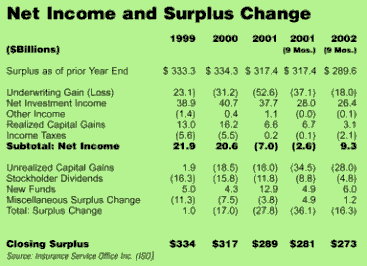Following the property/casualty industry’s net loss after taxes in 2001, many analysts predicted 2002 would be the year of recovery.
In fact, strong premium growth and sharply lower catastrophe losses did lead to significant improvement in underwriting results. Based on actual industry results through September, Insurance Service Office Inc. (ISO) estimates that premium growth for all of 2002 accelerated to 14.1 percent from 8 percent in 2001. ISO also estimates that the combined ratio improved to 106.7 percent in 2002 from 115.9 percent in 2001.
Actual results through last September show that strong premium growth and lower catastrophe losses enabled the industry to earn $9.3 billion in net income after taxes—in sharp contrast to its $2.6 billion net loss through Sept. 2001. But, capital losses on investments drove surplus down 5.6 percent to $273.3 billion on Sept. 30 from $289.6 billion at year-end 2001, despite the recovery in net income (see table).
Deeper analysis of the industry’s financial performance through last September reveals that insurers face an array of challenges spanning both the underwriting and investment sides of the business.
On the underwriting side, ISO’s analysis indicates that insurers are substantially under-reserved for past losses, even excluding asbestos claims. And, losses from asbestos and mold continue to mount. Insurers also remain dangerously exposed to future terrorist attacks, even with the recently enacted federal backstop. On the investment side, low market yields have cut into investment income, and declines in stock markets have generated capital losses.
Here is ISO’s take on the industry’s financial results last year and its prospects.
Underwriting results
Written premiums for the first nine months of 2002 rose to $279.8 billion from $246.4 billion through nine-months 2001. The catastrophe losses included in insurers’ results through Sept. 2002 declined to $4.1 billion from $16.3 billion through Sept. 2001. The $16.3 billion reflects ISO’s estimate that U.S. insurers’ reported results for the first nine months of 2001 included $9 billion in net losses from the terrorist attack on Sept. 11. ISO projects that losses from the attack will ultimately total $30 billion to $50 billion, with perhaps half of that amount covered by U.S. insurers.
Reflecting the growth in premiums and the decline in catastrophe losses, the industry’s net loss on underwriting through nine-months 2002 fell 51.4 percent to $18 billion from $37.1 billion through nine-months 2001. The combined ratio improved to 104.9 percent for the first three quarters of 2002, 9.5 percentage points better than the 114.4 percent for the same period in 2001. The decline in catastrophe losses accounts for 5.2 percentage points of that improvement.
Almost half the improvement in underwriting results for the first nine months of 2002 came from premium growth in excess of growth in noncatastrophe losses and other expenses. Data from ISO MarketWatch™, which provides information about changes in premiums at renewal for actual commercial lines policies, shows that commercial insurance markets began firming in mid-1999, with rate changes on renewals accelerating in the wake of the terrorist attack on Sept. 11, 2001.
Investment results
Deterioration in investment results drove industry surplus lower through nine-months 2002, despite significant improvement in underwriting results.
Insurers’ net investment income dropped 5.4 percent to $26.4 billion through nine-months 2002 from $28 billion through nine-months 2001. The decrease in investment income reflects a decline in the yield on investments. Insurers’ average holdings of cash and invested assets during nine-months 2002 were 1.6 percent above their average holdings a year earlier. But the yield on cash and invested assets fell 6.9 percent versus a year ago.
Realized capital gains through nine-months 2002 fell to $3.1 billion, down 53.9 percent from $6.7 billion for nine-months 2001. Netting realized capital gains against $28 billion in unrealized capital losses through nine-months 2002 insurers suffered $25 billion in overall capital losses. Those losses were a direct result of weakness in stock markets. The S&P’s 500 declined 29 percent through Sept. 30, 2002.
Prospects
While many industry observers predict continued firming in insurance markets through year-end 2003, ISO MarketWatch data shows that increases in commercial premiums at renewal are already losing momentum. The cyclical nature of the insurance business implies that slowing increases will be followed by decreases—the only question is when.
Barring major catastrophes, underwriting results should continue improving in 2003 strong premium growth works its way down to the bottom line. But terrorism and catastrophic natural disasters remain ever-present threats.

Michael R. Murray is assistant vice president – Financial Analysis, Insurance Services Office Inc. (ISO)
Topics Catastrophe Carriers Profit Loss Underwriting Property Property Casualty Casualty
Was this article valuable?
Here are more articles you may enjoy.


 AIG Sues Newly Launched Dellwood Insurance and Its Founders
AIG Sues Newly Launched Dellwood Insurance and Its Founders  Carnival Puts Miami Headquarters Up for Sale as Florida Real Estate Soars
Carnival Puts Miami Headquarters Up for Sale as Florida Real Estate Soars  California Sees Two More Property Insurers Withdraw From Market
California Sees Two More Property Insurers Withdraw From Market  JPMorgan Client Who Lost $50 Million Fortune Faces Court Setback
JPMorgan Client Who Lost $50 Million Fortune Faces Court Setback 


